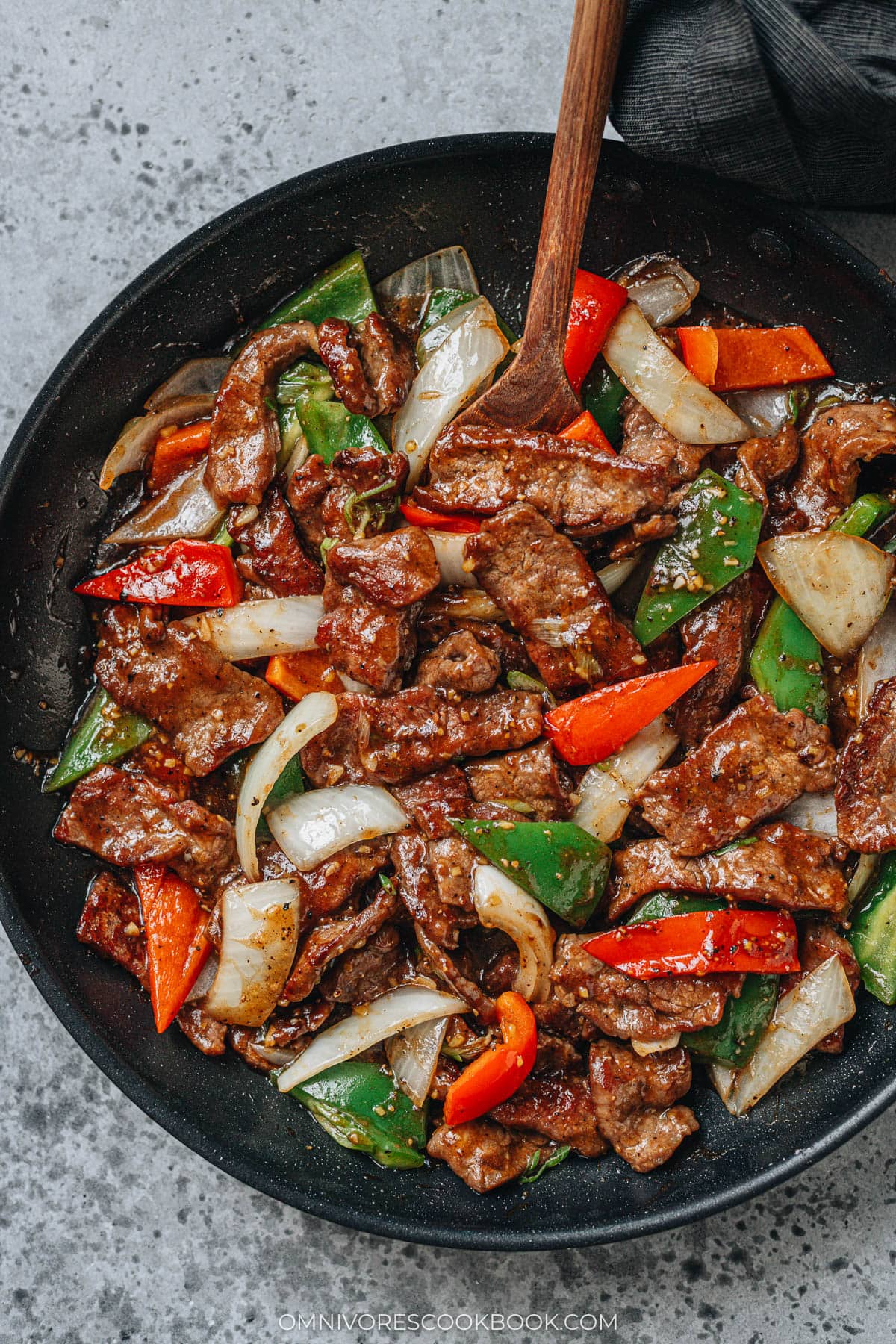
Chinese black pepper steak is a popular dish at Cantonese restaurants. It is a bold and savory stir fry that brings together tender beef, crisp vegetables, and a sauce that strikes the perfect balance between peppery heat and savory umami. Unlike Western steak dinners, this dish is all about bite-sized pieces cooked quickly over high heat to create tender juicy beef that is coated with a velvety sauce. It is quite quick to put together, making it ideal for a weeknight.
Ingredients
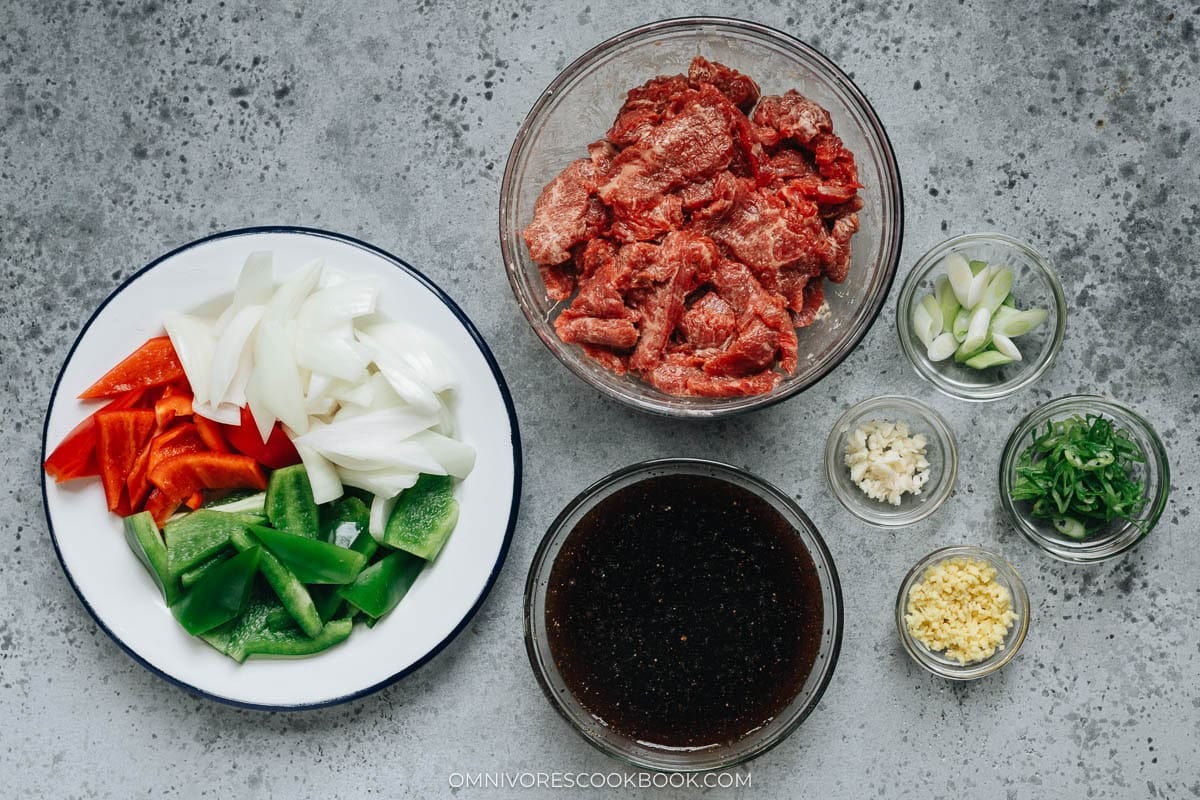
What beef cut to use and how to prepare
Tender cuts like flank steak, sirloin, and ribeye work best. My favorite cut for stir fry is always flank steak, which is well marbled, has a rich flavor, and is very tender.
To cut flank steak, I always divide it into two large pieces along the grain, then slice them further against the grain into bite-size pieces. To achieve nice even pieces, I like to tilt my knife to a 45 degree angle for a slightly wider slice.
I use soy sauce and Shaoxing wine in the marinade for seasoning. Cornstarch is used to coat the beef, so it’s protected from the high heat and yields a tender texture. To achieve restaurant-style texture, I also use baking soda in the marinade. It breaks down the tough tissues in the beef, keeping it extra tender and juicy. It also removes moisture from the surface, so the beef browns and crisps up effectively.
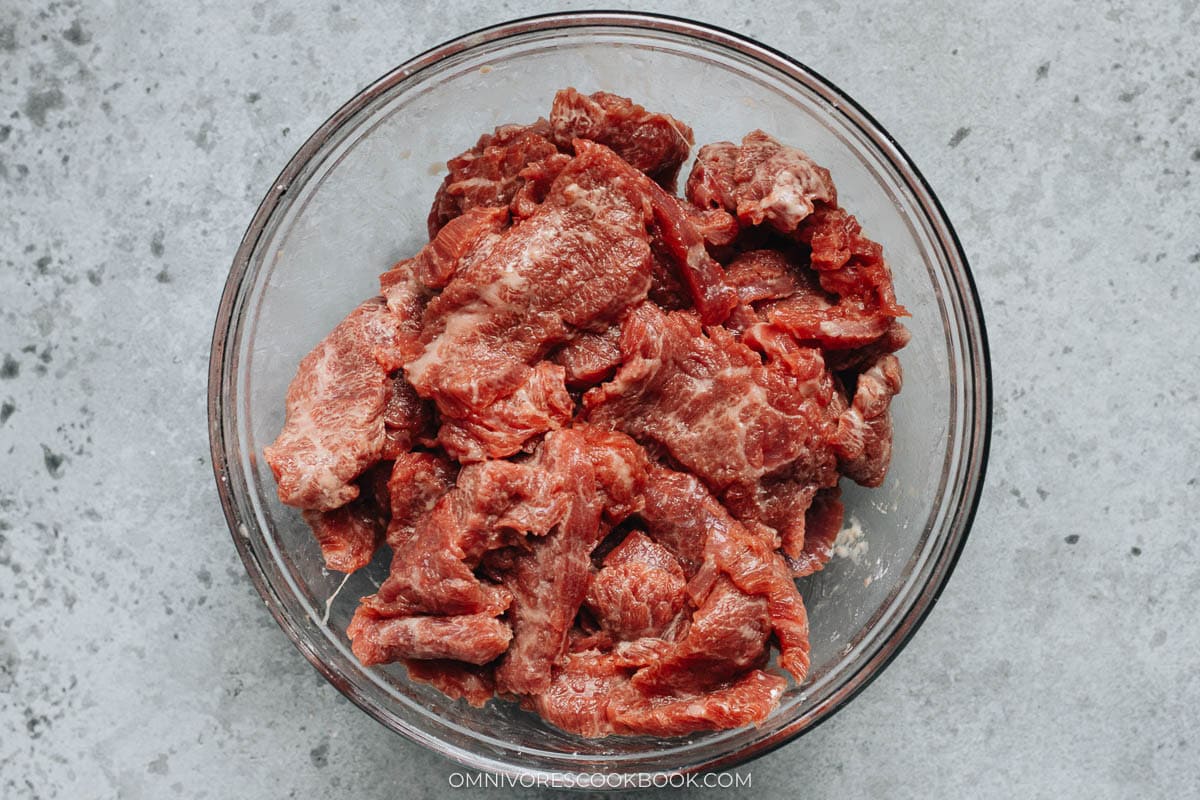
The Sauce
The magic of this dish lies in its sauce. A typical black pepper sauce is made with:
- Chicken stock for more body and extra sauce to coat the beef
- Light soy sauce for saltiness and umami
- Dark soy sauce for the dark brown color
- Shaoxing wine to round out the flavors
- Sugar to balance the sharpness of the black pepper
- LOTS of coarsely ground black pepper for the main flavor
How I cut my vegetables
I like to cut peppers and onions into pieces that are similar to beef. To achieve the cut, I first slice the pepper into halves. Then I tilt my knife lightly to slice off a triangle, and tilt the knife again to slice off an irregular shape.

Vegetable options
While onions and bell peppers are the most traditional choices, you can also use snap peas, hot chili peppers, mushrooms, or blanched broccoli. Their crispness contrasts beautifully with the tender beef and silky sauce.
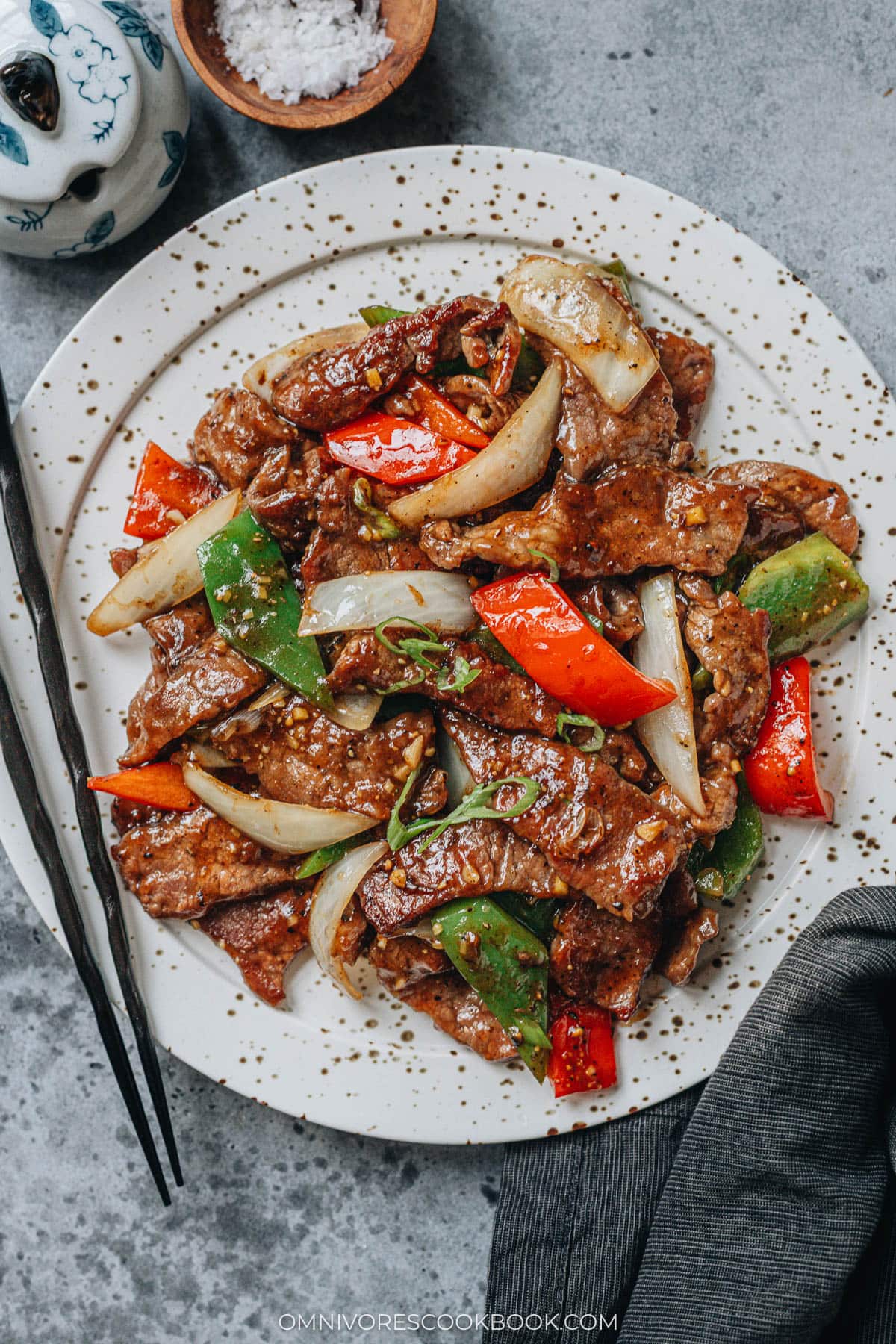
How to make
Sear the steak in a hot pan. Depending on the size of your pan, you might want to cook in two batches so the steak can be spread out evenly without overlapping. Since we use baking soda, you will notice the steak brown easily over high heat. Do not stir it once you’ve spread out the steak, and only flip it once it is browned. As soon as the center is no longer pink, take it out immediately to avoid overcooking.
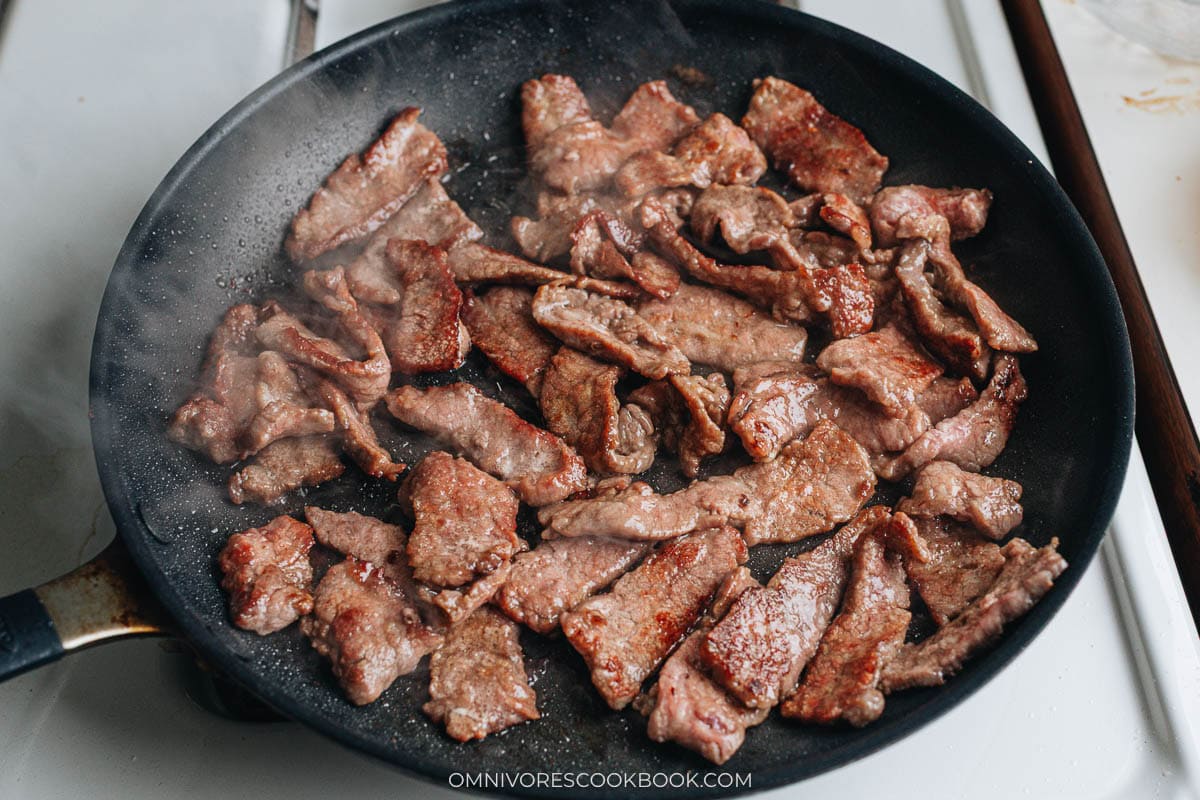
Cook the aromatics to infuse the oil. I always put my pan on a lower heat since the pan will have residual heat from cooking the steak.

Stir fry the vegetables. Chinese restaurants usually cook the vegetables briefly, so they remain very crisp. But if you prefer your vegetables a little more tender, you can cook them a little longer. Just remember, the vegetables will keep cooking after you add the sauce and will soften a little more later into the cooking.
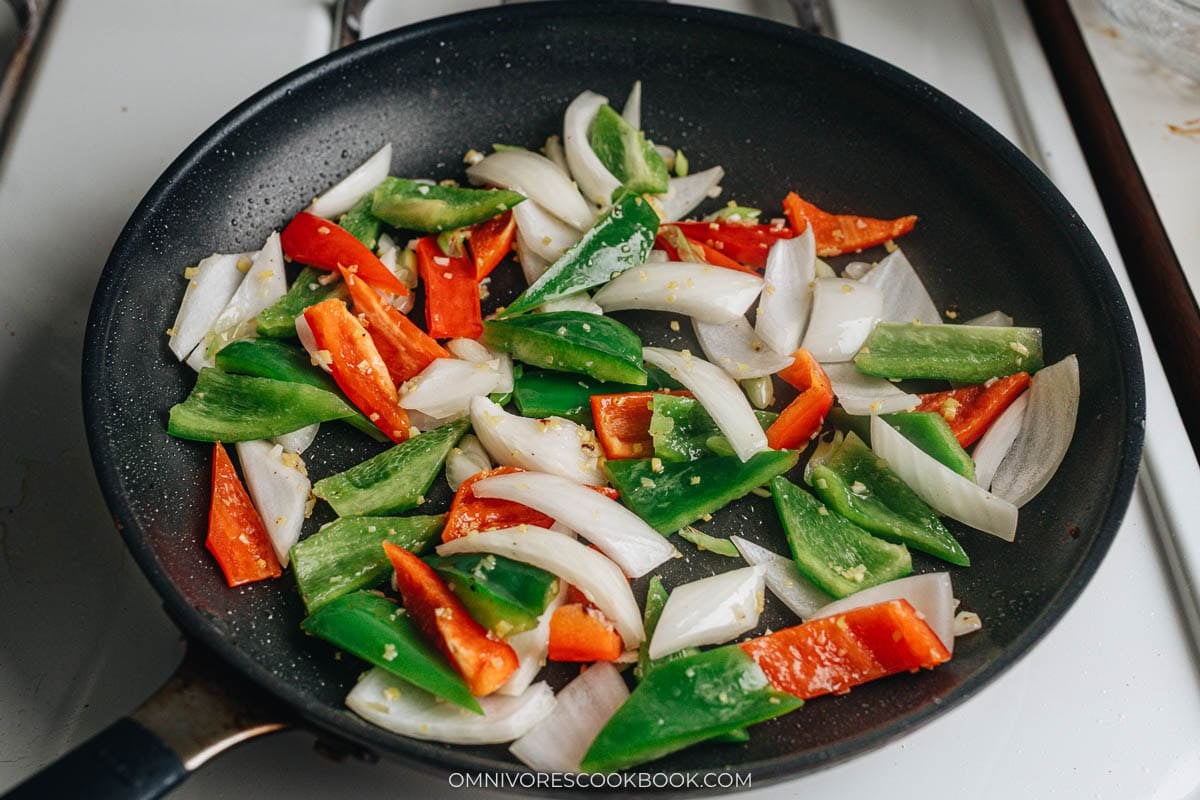
Lastly, add the sauce, reduce it, and add back the steak. Always stir the sauce until the cornstarch fully dissolves again before adding it, because the starch tends to settle on the bottom of the bowl. The last step happens very quickly. You want to stir everything together quickly, then transfer it to a plate, so the ingredients won’t keep cooking in the residual heat of the hot pan.
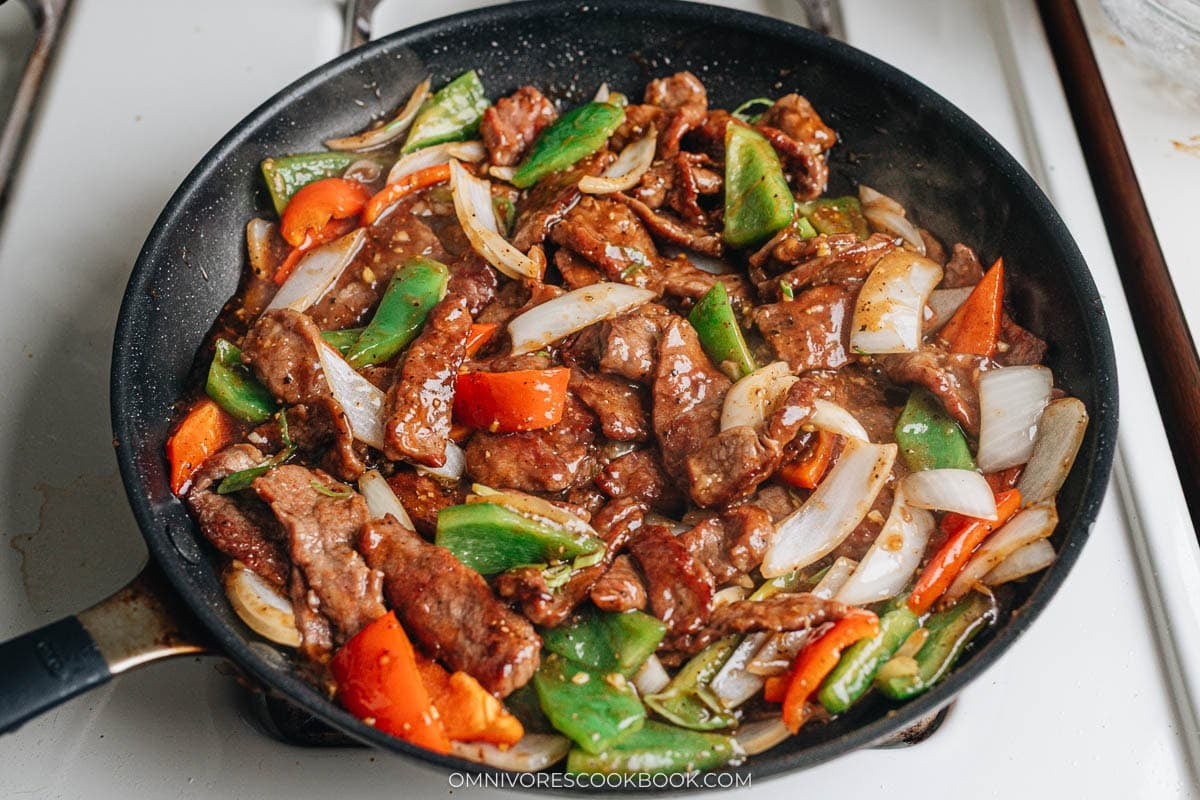
Why do I use a skillet instead of a wok?
Even though every single Chinese cookbook insists on using a wok for stir fry, I found that a nonstick skillet works perfectly for my kitchen. My vintage kitchen has a gas range with low output (9000BTU), which does not heat up a wok properly. With a large flat skillet, the pan will be heated up more evenly and I will have more surface to work with. Not only can I make beautifully charred steak with a great flavor, but I can also use less oil and the steak will not cause any sticking problems.
If you’re curious about the pros and cons of a wok, read my article 10 reasons not to use a wok. And if you want to know about the perfect stir fry setup, read wok vs. stir fry pan.
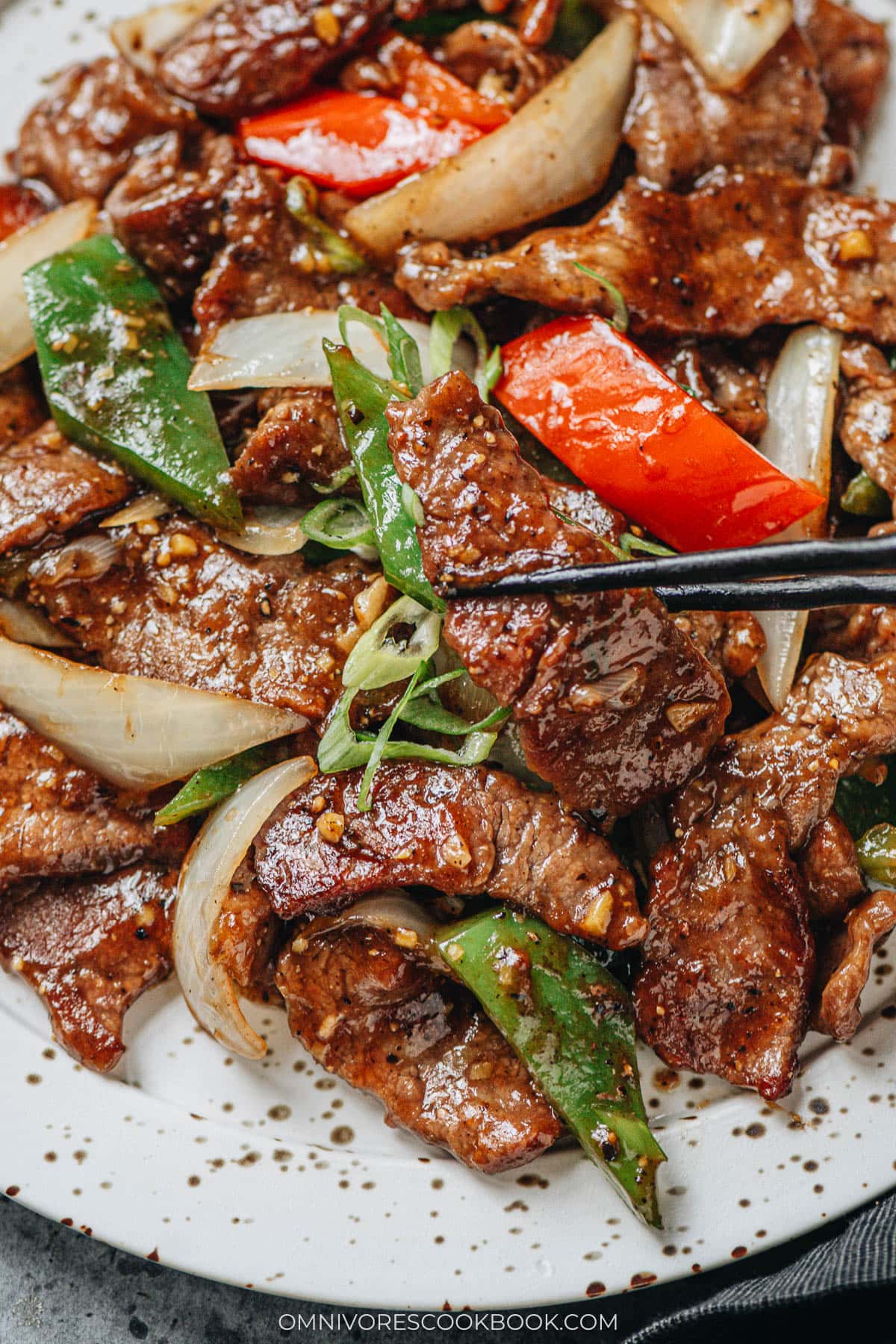
Frequently asked questions
Is fresh ground black pepper necessary?
Yes. Freshly ground black pepper gives the sauce its signature sharp, aromatic flavor. Pre-ground pepper won’t taste as vibrant. I also like to use coarse ground pepper for texture.
How do I prevent the beef from getting tough?
Avoid overcooking by searing quickly over high heat, then removing it from the pan before stir-frying the vegetables. Add it back only at the end. The cornstarch and baking soda in the recipe help the beef remain tender in the hot pan.
Can I make this ahead of time?
It’s best eaten fresh because the beef can toughen and the vegetables lose their crunch if reheated. If you have leftovers, they can stay in the fridge for two to three days without any issue. If you’re hosting and want to prepare it ahead of time, marinate the beef, mix the sauce and slice the vegetables. Store everything in the fridge and cook the dish right before serving.
More Chinese stir fry recipes
- Sweet and Sour Chicken
- Beef Chow Fun
- Beef and Broccoli
- General Tso Tofu
- Orange Chicken
- Shrimp Chow Mein
Chinese Cooking Made Easy
Are you new to this website? This free email series is a great place to start. I’ll walk you through a few of my most popular recipes and show you how and why they work. You’ll quickly start to cook better Chinese food in your own kitchen.

Black Pepper Steak (黑椒牛柳)
Ingredients
- 1 lb flank steak
Marinade
- 2 teaspoons soy sauce
- 2 teaspoons Shaoxing wine
- 2 teaspoons cornstarch
- 1/2 teaspoon baking soda
Sauce
- 1/2 cup chicken broth (*Footnote 1)
- 2 tablespoons Shaoxing wine
- 2 tablespoons soy sauce
- 1 teaspoon dark soy sauce
- 1 tablespoon cornstarch
- 2 teaspoons coarsely ground black pepper
- 1 teaspoon sugar
- 1/8 teaspoon salt (skip this if you use salted Shaoxing wine)
Stir fry
- 2 tablespoons peanut oil (or vegetable oil)
- 2 teaspoons ginger , minced
- 2 cloves garlic , minced
- 1/2 yellow onion , sliced (*Footnote 2)
- 2 bell peppers (I used green and red, sliced) (*Footnote 2)
Instructions
- To cut flank steak, divide the steak lengthwise into two equal pieces along the grain. Then slice each piece against the grain into 1/8” (3-mm) thick pieces. If the flank steak you use is quite thin, you can tilt your knife to a 45 degree angle so the slices are wider.
- Combine steak, soy sauce, Shaoxing wine, baking soda, and cornstarch in a medium-sized bowl. Gently mix by hand until the beef is coated with a thin layer of the mixture. Marinate for 15 minutes while preparing the rest of the ingredients.
- Combine all the sauce ingredients in a small bowl. Mix well and set aside.
- Heat 1 tablespoon of oil in a 12” skillet (or a wok) over medium-high heat. When oil is shimmering, add the steak. Immediately spread the beef into a single layer using a pair of tongs or chopsticks. Sear without moving until the bottom is browned, 1 to 2 minutes. Flip the beef and cook until just cooked through, another minute or so. Turn to the lowest heat and transfer the beef to a plate, set aside.
- Add the remaining tablespoon of oil into the same skillet and reduce to medium heat. Add the ginger and garlic. Give it a quick stir until fragrant. Add the onion and peppers. Stir and cook for 1 minute.
- Stir the sauce mixture until the cornstarch is dissolved completely, and pour it into the skillet. Stir with a spatula immediately and cook until the sauce thickens enough to coat the back of a spoon, a few seconds. Add back the cooked beef. Quickly stir a few times to coat everything with the sauce. Turn off heat and immediately transfer everything to a big plate. Serve hot as a main dish.
Notes
- I used chicken stock because it’s something I always have in my pantry. Feel free to use beef stock for a beefier flavor.
- I like to slice the onion and pepper into similar pieces as the steak. Instead of slicing them into long, thin slices, I like to slice on the bias into shorter pieces. Check the pictures in my blog post above to see how I cut the vegetables.
- For a gluten free dish: use tamari instead of soy sauce and use dry sherry instead of Shaoxing wine.
Nutrition

Did you make this recipe?
I’d love to hear how it turned out for you! Please take a moment to leave a 5-star rating ⭐️ and share your thoughts in the comments further down the page. It really helps others discover the recipe too.

Carolyn
Worked perfectly as written. Looking forward to making this again soon!
HALENA
CAN YOU USE ANY RED WINE?
Maggie Zhu
I’ve never tried but I think it should work! The flavor will be different but it should taste nice.
Heather
My husband and I really enjoyed this recipe! We moved and lack serious Chinese/Cantonese cuisine. This was quite similar to the one I always order at one of my favorite Cantonese restaurant.
Vickie
This recipe was perfect! I increased the sauce a bit because I added some extra vegetables. So easy to make!! I’ll be making this a lot!
Aunt Rosen
Super delicious! I added 1/8 tsp ground white pepper to the sauce because my family really loves the flavor.
Terracharm Alexander
Your recipes are superb we all loved this one!
Brittany
Does the sherry wine have to be dry? I’m only finding dry sherry dessert wine
Maggie Zhu
Yes it has to be dry otherwise the dish will end up too sweet. The dessert wine also has a very different taste.
Could you find Japnaese sake? It is a good alternative if you cannot find dry sherry.
Gracia
Taste really good👍
Regina
Other than doubling the black pepper (since we love it spicy), I kept everything the same. I made it for a Lunar New Year’s feast and it was a hit.
Dana
This was delicious! We just used vegetables in the dish (peppers, onions, broccoli, carrots, cauliflower) and served it over rice. It will be added to the rotation. Thanks!!
Dave
Thank you for this recipe Maggie, this was fantastic! I chose yours over others online for two reasons – it has onions, and detailed step-by-step directions. I had everything called for except the Shaoxing wine, so I substituted Extra Dry Vermouth, which seemed to work fine. I not very experienced at cooking Asian dishes – I usually let my Asian girlfriend make those 🙂 so I followed your directions to the letter and was amazed how well it came out. Served it over white rice with a sprinkling of sesame seeds – looks just like the photos! Will fry an egg to go with the leftovers. And I’ll be back to try more of your recipes…
Cheryl Ding
Thanks for the tips on cooking the beef this is always tricky, I made this and everyone loved it! :))) thank you Maggie!
Susan Chee
Great recipe, Maggie! I followed your instructions, even right down to having the sunny side up egg on top of the serving of rice and it turned out really well. I browned the sirloin steak in 2 batches so the pieces had a nice colour to them. The family truly loved this dish and this is one of many from your repertoire of excellent dishes which will be repeated often. I chanced upon your website only recently and am really happy that I did as your dishes are not difficult to perfect since your instructions are quite clear and most helpful. You’d be pleased to know that because I have had so many opportunities trying your recipes, my husband has now declared that he doesn’t think he wants to have any more Chinese meals at restaurants as they aren’t as good as my home cooking!
Sashe Saarns
Maggie,
In step 5, your recipe calls for ginger (it is not listed)–fresh? ground? how much?
I re-read the recipe several times—did I miss something? And someone else mentioned green onions—where do these go and when and how much?
I just bought a WOK and had such a wonderful dining experience with this dish at local Chinese restaurant (they have a really great market attached too!). I am anxious to try in my home kitchen, but am too insecure to “wing it “without knowing what to do with these omitted ingredients. I am sure that you are so accustomed to cooking these dishes that sometimes you overlook some things because they are so second nature to your cuisine but some of us need “specifics”. Thank you!
Maggie
Hi Sashe, I just updated the recipe so now it has all the info and correct format.
Sorry about the confusion! I moved all my recipes from another template and the format got messed up during the process. I’m fixing things little by little but it takes a long time. Thanks for letting me know about the missing ingredient.
Re green onion, I eliminated green onions when I updated the recipe. So you don’t need them in this recipe.
Happy cooking and can’t wait to hear your feedback on this!
Joseph Lomsak
I made this meal exactly as directed. This was the best ever! It lasted for about 10 Min’s! ALL GONE!!!!! Wonderful!!!!
Shirin
Hi Maggie,
Is it possible to make this dish without the wine?
Maggie
Hi Shirin, yes, you can replace the wine with a bit stock. Happy cooking!
Peter
I noticed in other beef dishes you drain the marinade sauce from the marinaded beef and mix in cornstarch using hands just before cooking marinaded beef. In this recipe it says to mix soya,wine and cornstarch together before marinating. I’m wondering why the difference. Thanks. Love your recipies.
Peter
Maggie
Hi Peter, the “drain and add cornstarch” approach is closer to traditional cooking and it’s the best way to minimize splatter.
Although I did change into the “mixing all together” method in my recent recipes, to simplify the recipe. I usually try to find the good liquid ingredient and cornstarch ratio, so it won’t produce extra liquid once the marinating process is done. You can follow the method. And when you notice there’s liquid in the bowl once the marinating is done, you should always drain it before the cooking to it won’t cause splatter.
Maria H
Happy with the result! First time making it without being too soupy as used to be 😀
Thank you for the good recipe and cooking/prep method! 😘👍
munir
great recipe i cook this all the time and im 12! great job! delicious! thanks so much maggie…ur the best
Keith Nicholson
Hi Maggie,
Thank you for your Weekly email… I really enjoy all your recipes and Instructions… Excellent Job…
I do have a question:
I still have difficultly keeping my Beef very tender(Like Restaurants) when Stir Frying… I always use my best Wok that is seasoned really well…
I have tried the method you suggest and also “Velvetizing” the beef ( Egg whites, Sake and corn starch – Marinate 1 Hr. – Then boil beef for seconds (No Salt in Marinade or Water)… I usually use Top Sirloin as the cut of meat… My finished product just is not as soft and tender as the Restaurant I eat at… Have you ever tried “Velvetizing” protein…? I do get the Wok very hot… The only change I can think of is to buy a really good “Dragon’s Breath” gas burner for the outside… Then I know the Wok will be Restaurant “HOT”…
Any Suggestions…? Or am I doing something wrong…? Should I use a different cut of beef…?
Again, I think your work is exceptional…
Thank You,
Keith
Maggie
Hi Keith, but boiling, do you mean boil the beef in the water? The velveting process can be achieved either by cooking the beef in the water or oil. My recipe marinates the beef first, then briefly cook them in the oil. So it has contained the velveting process.
If you want the beef extra tender, you can use baking soda during the marinating process. I explained the process in this post: https://omnivorescookbook.com/orange-beef/
Hope this is helpful!